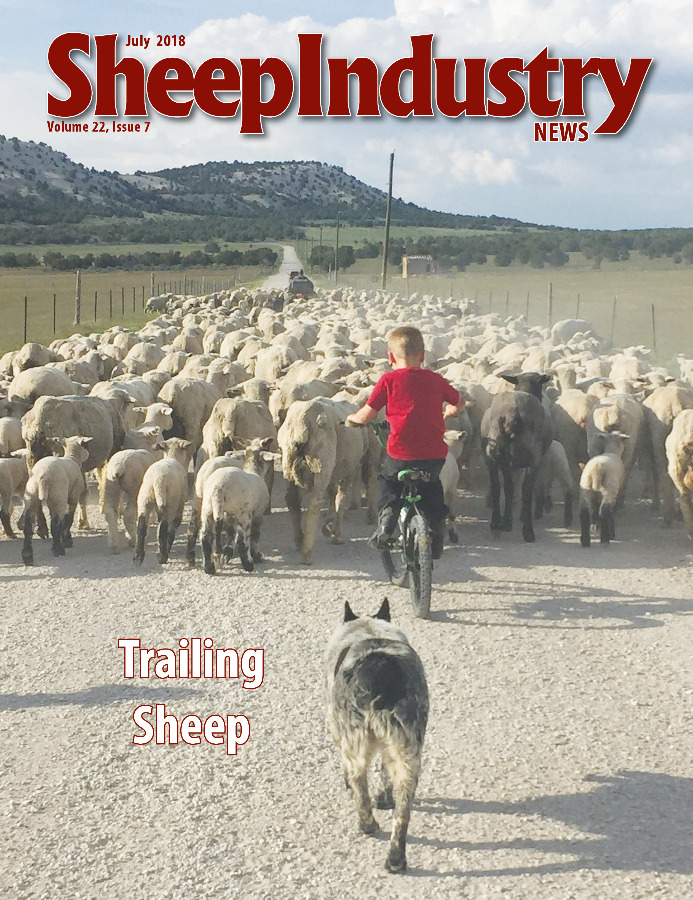
- July 2018
- President’s Notes
- Exports Drive Market for American Wool Producers
- Family Matriarch: Jeanne Siddoway
- IWTO’s 87th Congress Tackles Wool Sustainability
- NSIIC Budgets Funds for 2018 Grant Proposals
- Young Entrepreneur: Brady Campbell
- ASI News
- Around the States
- Obituary: Ernest “Bud” Gutzman
- Market Report
- Genetic Scrapie Resistance in Goats
- The Last Word
Exports Drive Market for American Wool Producers
How important is the export market for American wool? Seven of every 10 pounds of wool produced in the United States found its way to a container headed overseas in fiscal year 2016-17.
Of course, it hasn’t always been that way. There was a time when American manufacturing could put nearly every pound of American wool to use without it leaving the country. Then manufacturers exported those jobs to countries with cheaper labor, and the wool followed. China, India and Europe are now the major buyers of American wool.
Export numbers fluctuate from year to year, but it’s now the norm for at least half of the American wool clip to end up overseas. That number pushed to an all-time high in the past fiscal year, with China accounting for more than 50 percent of the export market. No other market came in higher than 15 percent of the exports – Western Europe was second at 13 percent and India purchased 11 percent of the exported wool.
What does all this mean for American wool producers? Selling your wool is now an international proposition. That could be a daunting task if not for a handful of programs developed by ASI and the U.S. Department of Agriculture’s Foreign Agriculture Service. Programs such as trade missions, reverse trade missions and the quality samples program play a key role in helping wool companies such as Anodyne, Groenewold, Keese, Lempriere and others sell American wool to the all-important international market.
“These markets have been key to the health of the American wool industry since the sudden decline of the wool processing industry in the late 1990s,” said ASI Deputy Director Rita Samuelson. “Today, with the export, domestic commercial and domestic military markets, American wool producers have various customers interested in their wool. And a healthy competition for that wool keeps prices at a higher price in a given market.”
Samuelson directs wool marketing for ASI and has decades of experience with tailoring FAS programs to benefit the American wool industry.
“As a cooperator of USDA/FAS, ASI was able to develop some key markets at a time when the industry had lost its longtime customer – the United States textile industry,” Samuelson said. “All sorts of wool is sold overseas – fine wool, coarse wool, short wool. It’s just a matter of helping the buyers find the wool they need. And that’s the whole purpose for these programs.”
A reverse trade mission in June with buyers from China resulted in the sale of 17 containers – 375,000 pounds (clean) worth $1.4 million – of wool. Of that, the wool was purchased from three different exporters and encompassed a broad range from fine wool to coarse.
Just as producers and manufacturers have adjusted to changes in the industry, so have the wool buyers. While Anodyne has long been a supplier of American wool to Burlington for use in United States military projects, the company sees exports playing an important role in the future.
“The government contracts are very stable, but the export side is where the growth potential is in the industry,” said Anodyne’s Terry Martin. “These programs help to level the playing field for a smaller company like ours. Without them, we would be a one-trick pony as just the supplier to Burlington.
“We now have some well-established clients overseas – relationships that we’ve developed in the past 18 years and a big part of that is these programs. As a small, family-owned operation, we’re probably one of the biggest users of these programs. Without them, I don’t know that we would be able to export. And that’s about half of our business these days.”
With wool prices at an all-time high, Martin said these are “nervous times” for everyone in the supply chain. “We’re trading in a commodity that is now worth millions of dollars. I’ve been in the business for 35 years and I never thought I’d see $4 a pound for greasy wool. It just takes my breath away. But we’ve got a great product to sell. Wool fits well in this whole farm-to-table trend that we’re seeing from consumers. That’s why the demand for wool is so strong.”
The quality samples program allows exporters to send small sample sizes to prospective customers and be reimbursed for related costs.
“It’s a very small part of what we do,” said Rick Powers with Lempriere, the leading exporter of American wool since 2005. “It’s a great way to target new clients and find a way to a price point that works for both sides. It’s also helpful if a client is looking to try a new type of wool.”
Even more valuable, however, are trade missions supported by ASI and FAS.
“Trade missions and reverse trade missions allow us to build relationships with clients,” said Powers. “We get to spend some one-on-one time with the clients, and that helps us find ways to fit American wool into their programs. The reverse trade missions bring new buyers to the United States almost every year, which is important. I can say that in 15 years of doing trade missions, I’ve been happy with the outcome 14 times and disappointed only once. So, I think that program is very valuable for us.”

